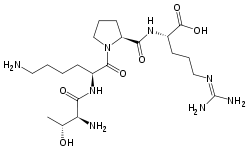Tuftsin
 | |
| Identifiers | |
|---|---|
| 9063-57-4 | |
| ChemSpider | 21244387 |
| |
| Jmol-3D images | Image |
| MeSH | Tuftsin |
| PubChem | 24780 |
| |
| UNII | QF5336J16C |
| Properties | |
| C21H40N8O6 | |
| Molar mass | 500.593 g/mol |
| Except where noted otherwise, data is given for materials in their standard state (at 25 °C (77 °F), 100 kPa) | |
| | |
| Infobox references | |
Tuftsin is a tetrapeptide (Thr-Lys-Pro-Arg) produced by enzymatic cleavage of the Fc-domain of the heavy chain of immunoglobulin G. It is produced primarily in the spleen.
Function
Its biological activity is related primarily to the immune system function.
Tuftsin binds to specific receptors on the surface of macrophages and polymorphonuclear leukocytes, stimulating their migration, phagocytic, bactericidal, and tumoricidal activity. It also influences antibody formation.
Pathology
Tuftsin deficiency, either hereditary or following splenectomy, results in increased susceptibility to certain infections e.g.: caused by capsulated organisms as: H. influenza, pneumococci, meningococci and salmonella.[1]
Clinical significance
Tuftsin has been chemically synthesized and it is considered for use in immunotherapy.
History
Tuftsin was first identified in 1970 by scientists Najjar and Nishioka.[2] It was named after Tufts University where the peptide was discovered.
References
- ↑ Online 'Mendelian Inheritance in Man' (OMIM) 191150 - "Tuftsin deficiency"
- ↑ Najjar V, Nishioka K (1970). ""Tuftsin": a natural phagocytosis stimulating peptide" (ABSTRACT PAGE). Nature 228 (5272): 672–3. doi:10.1038/228672a0. PMID 4097539.
See also
- Paraprotein